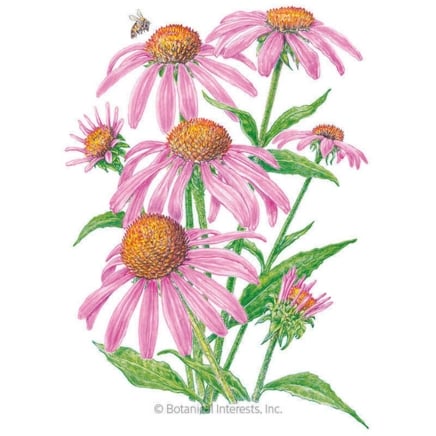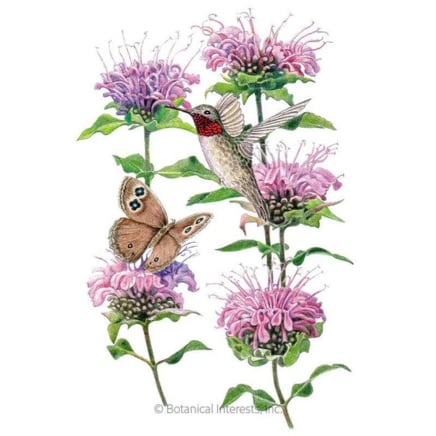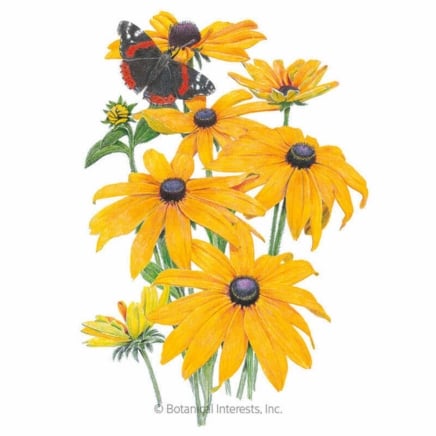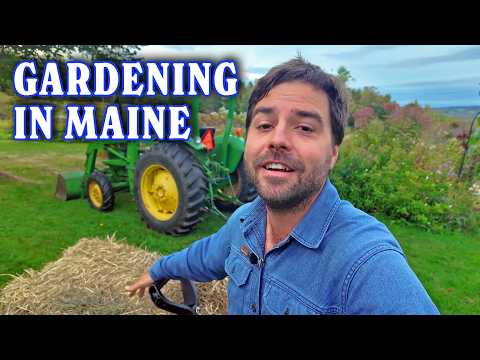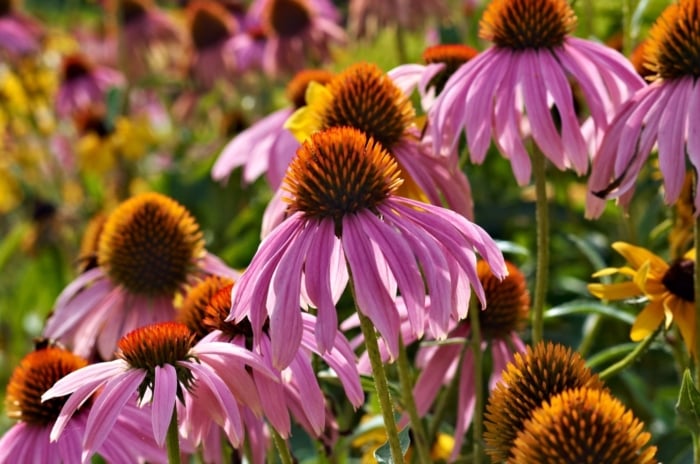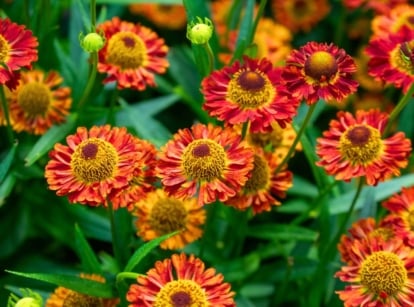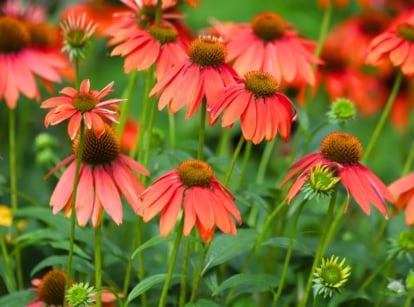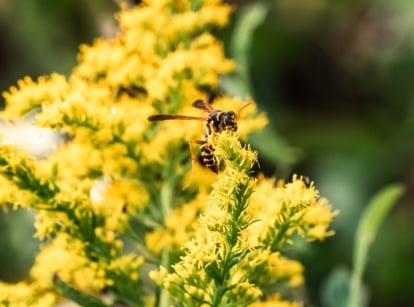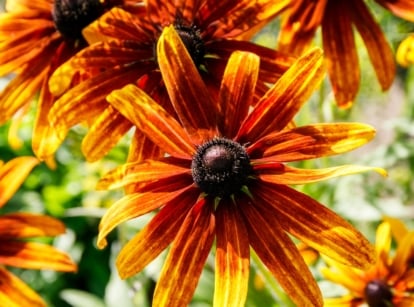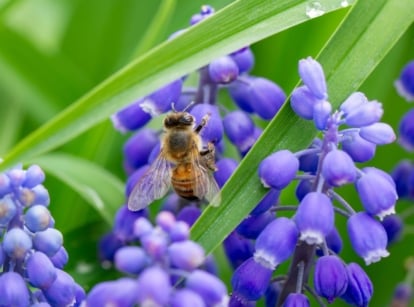11 Beautiful New England Wildflowers
The beautiful wildflowers of New England offer a colorful and diverse display through the growing season. Gardening expert Melissa Strauss shares some of the hardy plants that support local pollinators and thrive in a variety of habitats from woodlands to coastal areas.

Contents
The beautiful New England states experience a humid continental climate. Characterized by cold, snowy winters and warm, humid summers, this region boasts a diverse landscape. In this part of the country, you can find rocky areas, rolling hills, fertile river valleys, dense forests, mountains, and plenty of wildflowers.
The varied New England terrain supports a rich array of native plant life and distinct beauty. In spring, Virginia bluebells and columbine arrive with the fresh foliage of trees. In the summer, bee balm, milkweeds, and liatris brighten roadsides.
As we move into fall, species of goldenrod and aster provide an ample source of nectar for migrating pollinators. All of these wildflowers are not only beautiful but also valuable in supporting the local ecosystem. Here are some of the adaptable and beautiful wildflowers of the New England region.
Purple Coneflower

|
|
botanical name Echinacea purpurea |
|---|---|
|
|
sun requirements Full sun |
|
|
height 2’-5’ |
|
|
hardiness zones 3-8 |
Purple coneflowers are hardy perennials that grow well in New England’s climate. They thrive in full sun and well-drained soil, and tolerate heat, humidity, and even drought once established.
These wildflowers bloom from summer into fall. They have lovely purple petals and a prominent orange cone in the center.
In New England gardens, purple coneflowers provide both beauty and ecological value. They attract a wide array of pollinators, and their seed heads provide food for birds in the fall and winter.
Coneflowers aren’t native to the region, but they are adapted. They are also deer-resistant and long-lasting as cut flowers. They often self-seed, making them a low-maintenance choice for native gardens.
Wild Bergamot

|
|
botanical name Monarda fistulosa |
|---|---|
|
|
sun requirements Full sun to partial shade |
|
|
height 2’-4’ |
|
|
hardiness zones 3-9 |
This native perennial wildflower thrives in New England gardens. The soft purple blooms have a pleasant, minty fragrance and flower from mid to late summer.
Wild bergamot prefers full sun to partial shade and well-drained soil. It tolerates variable weather, including cold winters and humid summers.
This hardy member of the mint family is a favorite among pollinators. It adds a natural, meadow-like charm to native plantings, cottage gardens, and pollinator borders. Wild bergamot is also deer-resistant and relatively low-maintenance.
It can suffer from powdery mildew, though good air flow helps. Its aromatic foliage and unique flowers make it a standout in any New England garden.
New England Aster

|
|
botanical name Symphyotrichum novae-angliae |
|---|---|
|
|
sun requirements Full sun |
|
|
height 3’-7’ |
|
|
hardiness zones 4-8 |
New England aster is a native wildflower that shines in New England gardens. It has vibrant purple to pink blooms and bright yellow centers that bloom from late summer into fall. These New England wildflowers provide vital late-season nectar for bees, butterflies, and migrating monarchs.
This tall plant thrives in full sun and moist, well-drained soil. However, it’s adaptable to a variety of conditions. Its upright habit and rich color make it ideal for borders, wildflower plantings, and pollinator gardens.
New England aster pairs beautifully with goldenrod, which blooms at the same time.
Goldenrod

|
|
botanical name Solidago spp. |
|---|---|
|
|
sun requirements Full sun |
|
|
height 1’-6’ |
|
|
hardiness zones 3-9 |
Goldenrod is a native perennial wildflower that blooms in New England gardens from late summer into fall. There are several species native to the region, and they range in height from one to six feet.
Goldenrod thrives in full sun and a wide range of soils, including those with poor or dry conditions. It’s a hardy and low-maintenance choice for meadows, borders, and pollinator gardens.
Often unfairly blamed for allergies, goldenrod is a vital late-season nectar source for pollinators. Few people are actually allergic to this wildflower.
In New England, species like S. rugosa and S. canadensis are common and well-adapted. With its brilliant color and ecological benefits, goldenrod is a great option for supporting pollinators in the fall. It works well with the landscape in autumn too.
Black-Eyed Susan

|
|
botanical name Rudbeckia hirta |
|---|---|
|
|
sun requirements Full sun |
|
|
height 2’-4’ |
|
|
hardiness zones 3-9 |
Black-eyed Susan is a reliable wildflower. Its bright yellow flowers with dark central cones bloom from summer into early fall. It’s perfect for lighting up borders, meadows, and pollinator plantings with long-lasting color.
This native New England wildflower prefers full sun and well-drained soil but adapts well to various conditions. It even tolerates drought and poor soils.
Black-eyed Susans attract bees, butterflies, and birds that eat seeds. They’re both beautiful and ecologically valuable. Their hardy nature, ability to self-seed, and minimal maintenance needs make them a favorite.
Blue Vervain

|
|
botanical name Verbena hastata |
|---|---|
|
|
sun requirements Full sun |
|
|
height 2’-6’ |
|
|
hardiness zones 3-9 |
This native perennial wildflower adds vertical interest and rich color to New England gardens.
Blue vervain’s tall, slender spikes of small blue flowers bloom from mid to late summer. It thrives in full sun and moist to wet soil, making it ideal for rain gardens and the edges of ponds or streams.
This hardy plant can grow up to six feet tall and attracts a wide variety of pollinators. Blue vervain is also deer-resistant and adapts well to New England’s climate. It returns reliably year after year. With its elegant form, this wildflower is a strong choice for prairies and meadows, as well as pollinator-friendly landscapes.
Wild Lupine

|
|
botanical name Lupinus perennis |
|---|---|
|
|
sun requirements Full sun to partial shade |
|
|
height 1’-2’ |
|
|
hardiness zones 3-8 |
Wild lupine is a striking New England wildflower. It brings spires of blue to purple flowers to gardens in late spring to early summer.
It thrives in sandy, well-drained soils and full sun to light shade. This is an excellent choice for those parts of the garden that get fewer than six hours of daily sun.
Wild lupine is especially important in pollinator gardens, as it is rare and somewhat endangered. It is the sole host plant for the Karner blue butterfly caterpillar. It’s drought-tolerant once established and fixes nitrogen in the soil.
With its elegant blooms and ecological significance, this wildflower is a standout addition to New England gardens.
Butterfly Weed

|
|
botanical name Asclepias tuberosa |
|---|---|
|
|
sun requirements Full sun |
|
|
height 2’-3’ |
|
|
hardiness zones 3-10 |
Butterfly weed is a hardy, native perennial wildflower. It’s well known for its brilliant orange flower clusters that bloom from early summer.
This milkweed species prefers full sun and well-drained, sandy or rocky soil. It’s ideal for low-maintenance pollinator plantings and wildflower meadows.
Butterfly weed provides essential nectar and serves as a host plant for monarch caterpillars. It’s drought-tolerant once established and resists deer and most pests. Because it has a deep taproot, it does not transplant well, so it’s best to grow this wildflower from seeds.
Eastern Red Columbine

|
|
botanical name Aquilegia canadensis |
|---|---|
|
|
sun requirements Full sun to partial shade |
|
|
height 18”-24” |
|
|
hardiness zones 3-8 |
Eastern red columbine is a charming native New England wildflower. It blooms in spring to early summer. The red and yellow flowers attract hummingbirds, bees, and butterflies. It’s a valuable early-season pollinator plant.
This perennial thrives in part shade to full sun and prefers well-drained soil. It tolerates the rocky or woodland conditions often found in New England landscapes. It self-seeds readily, naturalizing in garden beds and areas of the garden that receive partial exposure.
Eastern red columbine boasts a graceful form, early blooms, and a strong appeal to wildlife. It’s an excellent choice for adding soft color to springtime gardens.
Virginia Bluebell

|
|
botanical name Mertensia virginica |
|---|---|
|
|
sun requirements Partial to full shade |
|
|
height 1’-2’ |
|
|
hardiness zones 3-8 |
Virginia bluebells are spring flowers that bring soft blooms in shades of pink and blue. Though not native, they bloom from April to May.
These perennials thrive in moist, rich soil and partial to full shade. They’re perfect for woodland gardens and other shaded spots in the garden.
In New England, Virginia bluebells emerge early, bloom beautifully, and then fall dormant by early summer. Their flowers are appealing to early-season pollinators, including bees and butterflies. With their delicate beauty and low maintenance needs, Virginia bluebells are a lovely addition to spring gardens.
Foam Flower

|
|
botanical name Tiarella cordifolia |
|---|---|
|
|
sun requirements Partial to full shade |
|
|
height 5”-1’ |
|
|
hardiness zones 3-9 |
This lovely native wildflower thrives in the shaded parts of the garden. Foam flowers produce airy spikes of small white or pale pink flowers in mid to late spring. The blooms rise above attractive, lobed foliage that sometimes turns burgundy or bronze in the fall.
Foam Flowers are suited to the region’s cool, moist wooded conditions. They prefer partial to full shade and rich, well-drained soil.
These New England wildflowers make excellent ground covers, spreading slowly by runners to form dense mats. They’re excellent for weed control. Their delicate blooms attract early pollinators, while the foliage provides visual interest well into fall.

